Just a few 'tube videos I found of Arduino music-making:
Auduino - The Arduino synthesiser
Arduino polyphonic synthesizer
Arduino drum machine
another Arduino drum machine
Arduino Sequencer
Plus check out this cool CDM article I just found that pretty much covers it: Making Music with the Arduino: Wires, Solder, and Sound Round-Up
Physical Computing, Tangible Interface, TUI/NUI, Interactive Scultpure, Music Control, OSC
12.17.2008
11.30.2008
Fabulous progress on Stribe1... Stribe8!
Stribe1 x 8 + new max/msp software demo from CuriousInventor on Vimeo.
Scott's been busy putting together a stribe1 x 8 and writing new firmware and patches. Also some promising experiments using 4051 chips to multiplex AD inputs on the Arduino. More info here
11.17.2008
A new simple Stribe app from Thyeks
This video is from "Thyeks", who lives in the Carribean. Here's a link to his app if you want to mess with it: [link]
11.12.2008
The Stribe is Dead... Long Live the Stribe!
The original Stribe Prototype kit has been discontinued (oh no!), but a new modular kit is taking it's place: the single-strip Stribe1 (yay!).
The Stribe1 kit (also available assembled) gives you everything you need to build a "single stribe" touch-control module, minus the microcontroller.

Multiple Stribe1s can be chained together with a ribbon connector and attached to the microcontroller of your choice.

For now we have building-block firmware and patches for the ATMEGA-based Arduino and Arduino MINI. Bitwacker (PIC) firmware is in the works.
The kit consists of a long and narrow PCB (~ 9 3/4" x 7/8"), a single 170mm touchstrip, 2 columns of 64 LEDs (128 LEDs total), and all the supporting circuitry, driver chips, ribbon connector, plexiglas enclosure, etc.

The instructions include step-by-step details on placing and soldering the parts, wiring it to an Arduino, and using the software.*
I think it would be fairly straightforward to hook one (or more) of these up to a monome 40h, but I'll defer the details to those who know the monome's internals better than I do. (Note: due to MUCH interest in this idea, I'll be trying this soon with my own 40h and will post my results)
The Stribe1 project was made possible with the generous involvement of Scott Driscoll of Curious Inventor (curiousinventor.com). He was kind enough to put my name on the project (and circuit board) even though he actually did most of the work.
Get yours here: http://curiousinventor.com/kits/stribe
* Note: assembly instructions are done, but we still haven't posted firmware, patches and Arduino wiring... Soon!
10.20.2008
Blue Ribbons

I was pleased and flattered that the Stribe receceived TWO "Editor's Choice" blue ribbons this weekend at Maker Faire Austin 2008. Thanks guys! It's a wonderful feeling to be recognized for all the long nights of hard work.

I made some terrific new friends and got to talk "geek" non-stop for 2 days!

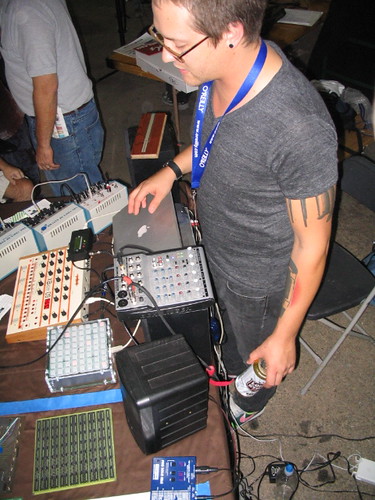
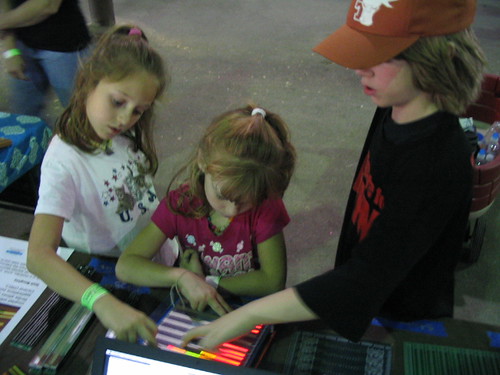
And of course it's always a distinct pleasure watching people discover the Stribe!
Special thanks go to stretta for his demo app, and to Vlad Spears for Scalar.
10.16.2008
Goin to the Faire

Heading to Austin tomorrow for the 2008 Maker Faire.
I'm bringing the Stribe along with a new firmware rev from Kid Sputnik to show off, along with an updated version of a Max patch written by Stretta.
Last year I went to the Faire in Austin with the original Stribe prototype under my arm and just wandered around, showing it to a couple folks. Then a few months ago I had my first booth at the San Mateo Faire - which was incredible. I plan to bring a bit less stuff, and the booth won't be quite as "fancy" this time.
I'm psyched to meet up with Scott Driscoll from Curious Inventor (http://www.curiousinventor.com), David Fowler from ucHobby (http://www.uchobby.com), and several others for a weekend of gettin' our geek on, and BBQ.
Scott and I have designed a new product, called "Stribe1", which is a single-strip stribe module - one touchstrip and 2 columns of LEDs. Soon we'll be selling these on his curiousinventor.com site, along with a variety of touchstrips from SpectraSymbol. There will be an official announcement and lots of pics and demos soon. Can't wait to see what people make with 'em!
Got my cowboy hat on and I'm mostly packed... I'll try to post some pics as the weekend progresses.
9.02.2008
How to Make a Cheap Multitouch Pad
via MTmini
The above demo shows 1/2 of the ingredients of a "true" multi-touch display.
To make images appear under your fingers instead of over on the computer's screen, takes only a few more steps:
1) Remove the IR filter from the camera so it can detect infrared, then add a filter over the lens to ignore visible light, so the camera only "sees" IR.
2) Add an IR source inside the box, pointing up (many commercially available security cameras already come configured with IR "blast" arrays, or they can be purchased as a separate unit, or make your own).
3) Exchange the tracing paper for a material that is still translucent yet allows IR light thru.
4) Add a little LCD projector next to the camera in the box, also pointed up.
TaDa!
Now your hands will be bathed in invisible infrared light. As your fingers approach and/or touch the surface, the camera "sees" IR blobs, which are then processed in software to differentiate touch and other gestures. The "Touchlib" library includes everything you need to process the images (as seen in the video). Now you project the image up onto the touch surface from below. The image is projected in the visible spectrum and so doesn't interfere with the IR blobs being received by the camera.
There is also a way to get crisper IR blobs, without bathing the user's hands in IR, by using a technology called "Frustrated Total Internal Refraction" (FTIR), popularized by Jeff Han. FTIR relies on the unique properties of acrylic sheet, e.g. it is extremely reflective on the inside surface, until touched (or until it gets dirty). By shooting IR into the edges of the sheet, touches are "seen" by the IR camera whenever the internal refractive properties of the acrylic are "frustrated" by being touched. Each touch bounces a blob of IR down into the camera.
*
I've been having some great conversations about multi-touch lately. What constitutes multi-touch? Does dual-touch count? Can multi-touch be "faked" on a single-touch surface using close timing of events (e.g. milliseconds apart)? What if you use the same approach on a dual-touch surface? Is this how the iPhone works (e.g. software detection of finger-spacing)? What about the Macbook's dual-touch mousepad? How does that work, anyways? Which technologies are dominating, if any? Capacitive, grid o' wires, heat sensing, IR bath? Which approach is typically used for which commercial application?
The above demo shows 1/2 of the ingredients of a "true" multi-touch display.
To make images appear under your fingers instead of over on the computer's screen, takes only a few more steps:
1) Remove the IR filter from the camera so it can detect infrared, then add a filter over the lens to ignore visible light, so the camera only "sees" IR.
2) Add an IR source inside the box, pointing up (many commercially available security cameras already come configured with IR "blast" arrays, or they can be purchased as a separate unit, or make your own).
3) Exchange the tracing paper for a material that is still translucent yet allows IR light thru.
4) Add a little LCD projector next to the camera in the box, also pointed up.
TaDa!
Now your hands will be bathed in invisible infrared light. As your fingers approach and/or touch the surface, the camera "sees" IR blobs, which are then processed in software to differentiate touch and other gestures. The "Touchlib" library includes everything you need to process the images (as seen in the video). Now you project the image up onto the touch surface from below. The image is projected in the visible spectrum and so doesn't interfere with the IR blobs being received by the camera.
There is also a way to get crisper IR blobs, without bathing the user's hands in IR, by using a technology called "Frustrated Total Internal Refraction" (FTIR), popularized by Jeff Han. FTIR relies on the unique properties of acrylic sheet, e.g. it is extremely reflective on the inside surface, until touched (or until it gets dirty). By shooting IR into the edges of the sheet, touches are "seen" by the IR camera whenever the internal refractive properties of the acrylic are "frustrated" by being touched. Each touch bounces a blob of IR down into the camera.
*
I've been having some great conversations about multi-touch lately. What constitutes multi-touch? Does dual-touch count? Can multi-touch be "faked" on a single-touch surface using close timing of events (e.g. milliseconds apart)? What if you use the same approach on a dual-touch surface? Is this how the iPhone works (e.g. software detection of finger-spacing)? What about the Macbook's dual-touch mousepad? How does that work, anyways? Which technologies are dominating, if any? Capacitive, grid o' wires, heat sensing, IR bath? Which approach is typically used for which commercial application?
8.23.2008
8.15.2008
scalar
A little demo of 'scalar', triggered by a stribe. Scalar is written by vlad spears, of 'balron' fame. By changing simple things like the sensor poll rate, sticky or non-sticky values, MIDI scale, and instrument mappings, I am able to play the stribe in a variety of modes.
Of course the stribe strips can trigger a much higher resolution map than this (1024 potential points of resolution per strip). Though it doesn't demonstrate this unique aspect of the stribe, it's still fun to play with. The strips are much more sensitive than buttons, requiring the lightest touch. Rolling a finger on it's "ball" can produce a variety of subtle effects, a slide from one note to the next, or produce a very rapid 'fingered' pattern.
LED feedback is minimal at this point. Still working on the firmware...
stribe.org
scalar
8.06.2008
monome & stribe in the UK
A newly-constructed Stribe Prototype effecting simple single-voice sequences running on a Monome 40h.
7.26.2008
Tenebre

Tenebre - Platinum Standard
Interesting lo-fi-ish production and good playing on this instrumental track. The sound is stylistically reminiscent of Pavement, Sebadoh, and Slint, with a little dose of Elephant Six thrown in, and at the end some bells. More bells!
Thought food

Giant Alphanumeric Nixie Tube available for lots of $ on the 'bay

Sometimes I go to this page and just listen to the default sounds

A couple of 3-dimensional alphabets. Info on the above alphabet. The image below I came across randomly and I can't find any information about it, so let me know.

Another 3D alphabet

CNMAT's experimental spherical speaker

Interactive Acoustic Modeling from Princeton. video
7.25.2008
Max/MSP night school at CNMAT
Hallowed hall
Watch my ever-growing-in-detail blog post here: http://soundwidgets.com/smf/index.php?topic=204.msg741#msg741
Hangin' with the big kids
7.04.2008
5.31.2008
Tablo - conductive fabric gesture controller

Adrian Freed's "Tablo"
"As the conductive stretchable fabric... is displaced towards the bowl it shorts out different lengths of ...conductive plastic... The result is a circular array of nearly mass-less displacement sensors. The gesture-to-displacement relationship changes according to distance from the center of the bowl..." read more
5.23.2008
A Bicycle Built for Two

Daisy.mp3
Original "Daisy" Song 1961
Max Mathews, John Kelly, and Carol Lochbaum
From a Wikipedia article on Max Matthews: "In 1961, Mathews arranged the well-known song Daisy Bell ("Daisy, daisy") for an uncanny performance by computer-synthesized human voice, using technology developed by John Kelly of Bell Laboratories and others. Arthur C. Clarke of 2001: A Space Odyssey fame was coincidentally visiting friend and colleague John Pierce at the Bell Labs Murray Hill facility at the time of this remarkable speech synthesis demonstration and was so impressed that he used it in the climactic scene of his novel and screenplay for 2001: A Space Odyssey, where the HAL 9000 computer sings the same song as astronaut Dave Bowman disables his cognitive functions."
5.12.2008
Awesome Maker Faire 2008 video
So far this is the best Maker Faire 2008 summary I've seen - it captures the diversity of projects and amazing stuff quite well. Note however that even this great vid represents barely 1/10 of the actual amazingness to be found at this huge Faire.
Oh, and look for a brief shot of The Stribe at about 7:34. :)
From: curiousinventor.com
Oh, and look for a brief shot of The Stribe at about 7:34. :)
From: curiousinventor.com
5.11.2008
Cycling74 mentions Stribe, and Electronic Musician article
Cycling74 has a nice mention of the stribe and a pic re: Maker Faire 2008
Electronic Musician May 2008: DIY Resurgence by Scott Wilkinson
Electronic Musician May 2008: DIY Resurgence by Scott Wilkinson
5.06.2008
The Stribe booth at Maker Faire 2008
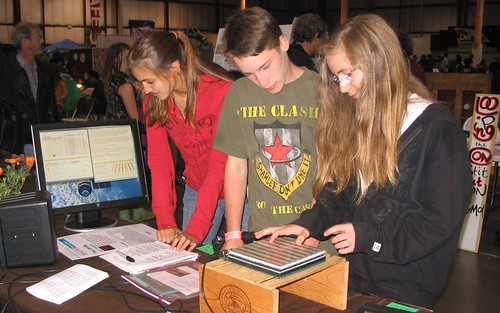
Some kids totally diggin' the way-out sounds
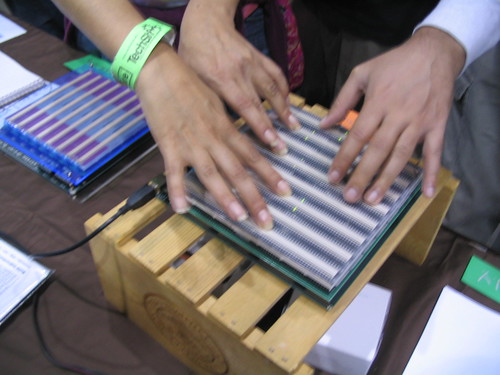
All hands on deck

Booth with stribe logo (made from construction paper)
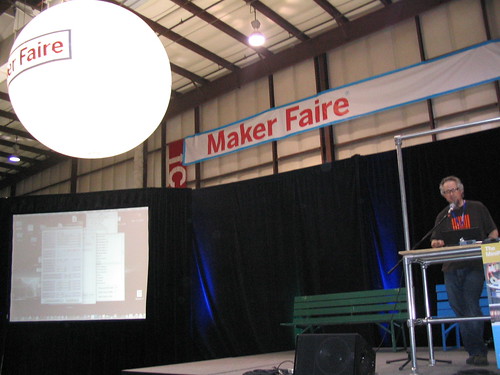
I gave a brief presentation about the Stribe - unfortunately I was completely unprepared and I had sound driver issues - better luck next time, I hope

Me (left) and Vlad (right), showing off the latest Stribe prototype
more: Flickr
5.04.2008
Maker Faire San Mateo, Day 1
Yesterday was the debut of the Stribe at Maker Faire, and it was amazing! A non-stop procession of fascinated people surrounded the booth for 10 straight hours. Stribe pioneer Vlad Spears totally saved the day when my MOTU interface gave up the ghost 2 hours into the demo. Just when I thought all was lost, Vlad stepped into the breach, fired up his own machine and held the crowd mesmerized with his lovely new Max 5 app, "Scalar", which made the Stribe into a wonderfully easy-to-play instrument. He manned the booth heroically and provided detailed explanations of the stribe, the monome, Max, and how it all fits together. I don't think he drank, ate, or sat down the whole time. My own demos pretty much relied on the MOTU, so without Scalar and Vlad it's hard to say what the day would have been like.
Thank You Vlad! You are a true rockstar, in every sense of the word.
I'm still a bit stunned at the level of interest and the many wonderful conversations I had with visitors and fellow Makers.
Today I hope to borrow an audio/MIDI interface from a fellow Maker and run some of my original demos, including a cool demo app written by stretta, along with a couple of my own creations.
Thanks to everyone who stopped by the booth on Day 1. I apologize if I didn't get to chat or you caught me in a flustered moment, but the onslaught of Make fans was unrelenting (which is really great) and I was overwhelmed at times. It was cool to meet members of the Stribe community in person, and I came away feeling both grateful and proud and just plain tickled. Something tells me this is going to be quite a ride. Thanks SO much for the enthusiasm and encouragement so far - it really does keep me going.
I have some great pictures and I'll post them as soon as I can. :)
Now it's time to get ready for Maker Faire, Day 2!
Thank You Vlad! You are a true rockstar, in every sense of the word.
I'm still a bit stunned at the level of interest and the many wonderful conversations I had with visitors and fellow Makers.
Today I hope to borrow an audio/MIDI interface from a fellow Maker and run some of my original demos, including a cool demo app written by stretta, along with a couple of my own creations.
Thanks to everyone who stopped by the booth on Day 1. I apologize if I didn't get to chat or you caught me in a flustered moment, but the onslaught of Make fans was unrelenting (which is really great) and I was overwhelmed at times. It was cool to meet members of the Stribe community in person, and I came away feeling both grateful and proud and just plain tickled. Something tells me this is going to be quite a ride. Thanks SO much for the enthusiasm and encouragement so far - it really does keep me going.
I have some great pictures and I'll post them as soon as I can. :)
Now it's time to get ready for Maker Faire, Day 2!
3.30.2008
stribe + MIDIbox = awesome app!!
From tk of midibox.org: "...Most of you guys are using Arduino based hardware, therefore I'm not sure if you are interested in an alternative approach, which is based on the MIDIbox hardware platform and MIOS. As the name implies, the focus is on MIDI communication instead of OSC via USB, accordingly this solution covers different usecases.
"The main difference to your current approach is the autarkic firmware, which doesn't require a computer to process the sensors, handle the LEDs, and to communicate with other MIDI devices. This might make it less flexible for experimental stuff, on the other hand I can easily add a LCD, buttons, more LEDs, rotary encoders, etc... - everything which is provided by MIOS - and control my MIDI synths directly..."
[more]
3.25.2008
red stribe wearing plexi
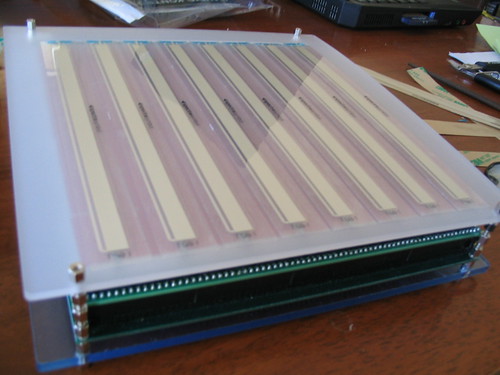
Some plexiglas test parts arrived from the Netherlands today via Xndr Industries. I assembled an all-red stribe with the new parts and it looks pretty awesome:
more pics here
3.22.2008
rockin the T-On
phineus + tenori-on + alesis micron from phineus on Vimeo.
I got a chance to play with a Tenori-On - it's pretty neat. Here I am testing out the MIDI implementation.
3.16.2008
The Stribe goes to Maker Faire

Finally emerging from the shadows, the Stribe will be at Maker Faire in San Mateo May 3 & 4, 2008. So get some sunblock and come to the Faire!
I visited the Maker Faire in Austin, Fall 2007 and it was awesome.

3.13.2008
3.11.2008
3.03.2008
free TR 606/808/909 for Windows

Who says you only get what you pay for? This donation-ware download from d-lusion is a hidden treasure for those in search of simple drum programming and great sounds on no budget. It's been around for a while but I came across it again recently and fell in love all over again with drum programming. Also check RubberDuck, a re-imagined TB-303, and the MJ Studio MP3 mixing tool. Don't forget to throw a few beans in d-lusion's Donation bucket for providing all this great stuff for free!
From the d-lusion site:
"Based on the concept of the legendary Roland drum synthesizers TR-909, TR-808 and TR-606 whose throbbing bassdrums and crashing hihats sent generations of dance-music enthusiasts into extasy, Drumstation combines cool old drum machine features with cutting-edge software synthesis technology. Drumstation is a drum software synthesizer and features 8 channels of drums (either samples or synthesized drum sounds), programmable via an easy-to-use step sequencer, effects (realtime reverb, delay, flanger, filter, distortion) for each channel, loops could be sliced and stretched.
"All this in the year 1998!
This free downloadable version also contains - beside the standalone software synthesizer - a complete set of free drum samples and effects to get you started (Roland TR-606, TR-808, TR-909, Real Drums, Sound Effects, DR-101, DPM-48, and additional Yamaha/etc. sampled sounds)."
3.02.2008
UK Sound Square project
"Input device from a matrix of IR beams set in a square. Fed into a Macintosh through a create HID interface. Processed with custom software written in Objective C and Quartz composer and fed to an MU10."
Mike Cook, in the UK, made a device similar to my Sound Square project (ca 1993), but smaller, and he went much farther with the software. Interestingly, he built it around the same time period (1994). At the time, a grid of sensors seemed like such a powerful meme to me that I assumed this type of music tech would be everywhere in no time. The fact that it HASN'T seemed to progress very far in 15 yrs was what put me on the path that eventually led to the Stribe. Well, 15 years later it seems Mike has dusted off his project as well! He has a great website and a page dedicated to the how-to of it all. Yay Mike!! Can't wait to see what comes next!
2.23.2008
Stockhausen on 'sounds', 1972
Very interesting 1972 lecture by Karlheinz Stockhausen (August 22, 1928 – December 5, 2007). He discusses synthesizing and transforming sound via technology, and the (then) theoretical possibility of speeding up a sound or piece of music without changing it's pitch.
2.20.2008
2.19.2008
2.14.2008
Gainer: Arduino-slayer?

The Gainer controller in Valentine Red
I saw some early press on this in 2007 that looked promising but now suddenly the Gainer website has really filled-out with tons of good information. This is a really interesting controller board that has a variety of possible configurations. Very intriguing - possibly a new heart for the stribe? Arduino MINIs are expensive (~$60 + shipping for the 2 Arduino stamps). Meanwhile the Gainer is open source and relatively cheap to build (~$30 USD in parts) and includes a USB interface. http://gainer.cc/
The Gainer can be configured for a variety of applications. Check out the specs.
Their website also links to this useful table of commercially avaialable sensor interfaces which I came across but then lost again. Here it is:
Comparison table of commercially available sensor interfaces
2.10.2008
stribe + monome 40h + balron + DSI monosynth
Here's the monome 40h running "Balron" while the stribe sends CC data to the DSI. There's a bug where the stribe sends a constant barrage of CC data so it's affecting the sounds a bit but it sort of works. I really should record the sound properly because my li'l camera mic really doesn't do it justice. It sounds huge!
2.07.2008
stretta literally rocks the monome 64
monome 64 tilt from stretta on Vimeo.
The latest monome.org offering, the 64, features a built-in tilt-sensor. Here stretta makes very interesting use of the feature.
1.30.2008
stretta + stribe
A Brief Conversation Resulting in One Less Child from stretta on Vimeo.
Something beautiful, at last!
don't fence me in
...mangled by monome + stribe.
This song is from my Texas friend Manda Clair's music sampler. I hope she doesn't mind. The video effects are for fun - these chunks are what my video editor thought made reasonable "scenes". I had to stack them all up to get the video to be continuous.
This song is from my Texas friend Manda Clair's music sampler. I hope she doesn't mind. The video effects are for fun - these chunks are what my video editor thought made reasonable "scenes". I had to stack them all up to get the video to be continuous.
hour of mindless fun

Make sure you have an hour to waste before clicking the link that takes you to this flash-based sequencer: Tony B Machine. Here's the history, google-ated from French.
1.29.2008
mlr + stribe pt II
somewhat better angle so you can see what's happening. only the left 4 strips are working in this app, controlling the volume objects in mlr. I' need to re-tune them to have a longer "throw" instead of only being audible near the top. Otherwise noise floor comes up on my crappy PA mixer.
It seemed like vlad had built in some way to make the channels stay on but I realize now that was the trigger from mlr turning them on. Once I started messing with their volumes, if I didn't re-trigger on the monome the volume would drop to zero. Clearly I need to add the "fader knob" feature to the firmware soon! :)
new stribe video - stribe + mlr
Super-short demo of using the Stribe to control volumes in mlr - basically using the stribe as as a MIDI mixer but via Max - stribe is in default firmware cursor mode, w/ no feedback from mlr, yet.
Also check out the in-progress stribe builder's guide
1.25.2008
monome 64: 100 units sell out in 2 minutes!

In about the time it took me to receive the e-mail that orders had begun and click through to the monome website - the 64 had already sold out! Simply amazing.
french flying-saucer music interface
1.18.2008
monome 10h!

monome will soon release their custom-designed 40h button-pads in combo with these smaller 4x4 circuit boards. Future 40h kit-builders can use 4 of these rather than one large 8x8 board (unclear if they've discontinued the 8x8 board). This design change arose from a discussion on the monome.org forum about alternative designs based around the 40h logic board and button pads. Instead of sawing the 8x8 board in half to build a 16x4 controller (which wouldn't work, anyways), these can be tiled as you see fit. I'm excited to see the variety of new controller configurations this will inspire...

;)
Of course you'll still have to tweak the monome software to run your wacky new configuration, but you should find plenty of kindred souls on the monome.org forum to help you find your way.
Check back with monome.org in late February.
1.14.2008
Subscribe to:
Posts (Atom)















